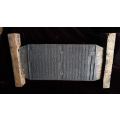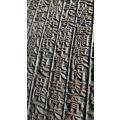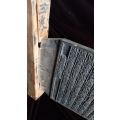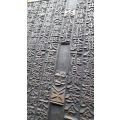Chinese Wood Printing Block, 18th to early 19th Century. Museum Quality. Make an Offer!!
Check my rate
| Main centres: | 1-3 business days |
| Regional areas: | 3-4 business days |
| Remote areas: | 3-5 business days |
Product information
EDIT: Chinese Woodblock Printing has been around since the 600s, but the process wasn't perfected until the end of the Tang dynasty (618-906). Initially, woodblock printing was bronze or stone seals molded onto clay and silk with ink rubbed together to inscribe texts. In 762, commercially printed books of medicine, agriculture, calendars, and auspicious charms were sold in the markets of Chang'an, the Tang capital.
Before the Song dynasty (960-1279), woodblock printing was used mostly for religious purposes. However, during this time period, the usage of printing was extended to manufacturing literature books and illustrations. The amount of color for the inks increased from one color to two colors--- black and vermillion. Song Dynasty used woodblock prints to circulate the standardized versions of the Twelve Classics that were printed from 932-955 along with other histories, philosophical works, encyclopedias, and medicinal books. In 971, the Tripitaka Buddhist Canon (Kaibao zangshu ) was completed in Chengdu. It took ten years and approximately 130,000 blocks to print the text. The Sichuan edition of the Kaibao Canon, known as Kaibao Tripitaka, was printed in 983.
Goryeo (now known as Korea), focused more on the religious aspect of the woodblock prints. In 989, Seongjoong of Goryeo sent one of his men to obtain a copy of the complete Buddhist canon from the Song Dynasty and was granted in 991 when Han Eongong was granted access to Song court.
In 1011, Hyeonjong of Goryeo began the operation of craving their own set of the Buddhist canon, known as Goryeo Daejanggyeong. The project was in a stalemate after Hyeonjong's death and the project wasn't resumed until 1046 after Munjong's accession to the throne. However, all 6,000 volumes and the original woodblocks were lost when the Mongols invaded in 1232. King Gojong ordered for a new set to be completed and it took 12 years to complete the new Goryeo Daejanggyeong in 1248. Goryeo Daejanggyeong is said to have 81,258 printing blocks, 52,330,152 characters, 1492 titles, and 6568 volumes; this Buddhist canon has survived in good condition for over 760 years and is considered the most accurate works written in Classical Chinese.
In the Ming dynasty (1368-1644), the printing techniques became more advanced that a full-color effect was implemented into the artworks. The consumption of woodblock printing multiplied as there was a variety of prints available on the market. The woodblock prints were applied to stories of people and places along with Lunar New Year prints and paper offerings. However, Chinese woodblock prints were crucial to society during that time as it was the main form of method with distributing pieces of information across the world. Woodblock prints also became a very influential product that affected culture and future innovations.
This block has individually carved Chinese characters on both sides, carved backward so the printed sheet could be read properly - Unfortunately I have been unable to find a translator of the block, in order to confirm whether it be religious, educational or something else. One such block (almost identical) can be seen in the British Museum. However, it has been confirmed as being Chinese. This is a rare object, so make an offer that suits you. Feel free to peruse other interesting objects from Safari Obscura. Thank you. 50cm x 28cm. Postage cost will be supplied on request, depending on destination



